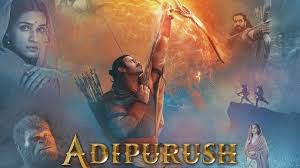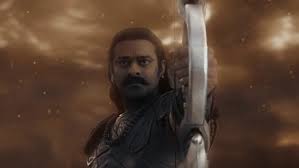🎬 Adipurush (2023)

Review of “Adipurush” (2023)
“Adipurush,” released in 2023, is a grand cinematic retelling of the epic Ramayana, helmed by director Om Raut. Starring Prabhas as Raghava (Lord Rama), Kriti Sanon as Janaki (Sita), and Saif Ali Khan as Lankesh (Ravana), the film ambitiously seeks to bring one of India’s most beloved epics to life on the big screen. Combining modern visual effects with the rich storytelling tradition of ancient mythology, “Adipurush” aspires to be both a tribute to and a reimagining of a tale that has shaped the cultural and spiritual fabric of India. However, the film’s execution has sparked a mix of admiration and criticism, leaving audiences divided about its legacy.
Plot Summary
The narrative of “Adipurush” closely follows the Ramayana, recounting the timeless tale of virtue, devotion, and the triumph of good over evil. The film opens with the abduction of Janaki by the demon king Lankesh, who desires her as his consort. Raghava, her husband and the prince of Ayodhya, embarks on an epic journey to rescue her, aided by his loyal brother Shesh (Lakshmana) and the mighty vanara (monkey) warrior Bajrang (Hanuman).
The story takes the audience through key moments of the epic: the forging of alliances, the construction of the bridge to Lanka, and the climactic battle against Lankesh’s formidable army. The themes of dharma (righteousness), love, and sacrifice are explored, with Raghava embodying the ideal of a just and compassionate leader, while Lankesh represents unchecked ambition and moral corruption.
While “Adipurush” largely adheres to the original narrative, it takes creative liberties to modernize certain aspects and make the story accessible to a global audience. This approach, while bold, has not been without controversy, particularly regarding its interpretation of characters and its visual style.
Themes and Symbolism
At its core, “Adipurush” is a tale of moral choices and their consequences. Raghava’s unwavering commitment to dharma and his selfless devotion to Janaki underscore the ideals of virtue and honor. Conversely, Lankesh’s arrogance and desire for power highlight the destructive nature of unchecked ego.
The film also emphasizes the importance of unity and faith. The alliance between humans, vanaras, and other beings symbolizes the strength found in cooperation and collective action. Additionally, Bajrang’s unwavering devotion to Raghava exemplifies the power of faith and loyalty.
Visually, the film employs grandiose imagery to reinforce its themes. The lush landscapes of Ayodhya and the ethereal beauty of Janaki’s presence contrast sharply with the dark, menacing visuals of Lanka and its demonic inhabitants. These aesthetic choices create a clear dichotomy between good and evil, mirroring the moral undertones of the story.
Performances and Characterization
Prabhas delivers a commanding performance as Raghava, embodying the calm dignity and inner strength of his character. While some critics have noted a lack of emotional range in certain scenes, his physical presence and charisma effectively convey the gravitas of a divine hero.
Kriti Sanon’s portrayal of Janaki brings grace and resilience to the character. She captures the emotional depth of Janaki’s plight, portraying her as both a devoted wife and a symbol of enduring strength. Her chemistry with Prabhas, though understated, adds a layer of intimacy to their relationship.
Saif Ali Khan’s Lankesh is perhaps the most polarizing aspect of the film. While he brings a menacing intensity to the role, his portrayal has been criticized for veering into caricature at times. The visual design of Lankesh’s character, with its heavy reliance on CGI, has also drawn mixed reactions, with some viewers finding it innovative and others deeming it distracting.
The supporting cast, including Sunny Singh as Shesh and Devdatta Nage as Bajrang, deliver solid performances that complement the central narrative. Bajrang’s scenes, in particular, are a highlight, capturing the character’s boundless energy and devotion.
Visual Effects and Direction
Om Raut’s vision for “Adipurush” is undeniably ambitious, with an emphasis on creating a larger-than-life experience. The film heavily relies on CGI to bring its fantastical elements to life, from the sprawling landscapes of Lanka to the supernatural abilities of its characters. While the visual effects succeed in some moments, such as the depiction of the battle sequences and the grandeur of Raghava’s divine aura, they falter in others, leading to a sense of inconsistency.
The depiction of Lanka, with its towering structures and dark, fiery aesthetic, is visually striking but occasionally feels overly stylized. Similarly, the character designs, particularly for Lankesh and his army, have been criticized for lacking the subtlety and nuance expected in a film of this scale.
Despite these flaws, Raut’s direction shines in the film’s emotional and dramatic moments. He captures the essence of the Ramayana’s timeless themes while attempting to present them in a way that resonates with contemporary audiences.
Music and Sound Design
The music of “Adipurush,” composed by Ajay-Atul, is a key component of the film’s emotional impact. The soundtrack blends traditional Indian instruments with orchestral arrangements, creating a sense of grandeur and spirituality. Songs like “Jai Shri Ram” serve as rallying cries, reinforcing the film’s themes of devotion and heroism.
The sound design, particularly in the battle scenes, adds to the immersive quality of the film. The clash of swords, the roar of mythical creatures, and the chanting of divine mantras create a rich auditory experience that complements the visuals.
Reception and Legacy
“Adipurush” has elicited a range of reactions from audiences and critics. While some have praised its ambition and faithfulness to the spirit of the Ramayana, others have criticized its execution, particularly the overuse of CGI and the creative liberties taken with the source material. The film’s portrayal of certain characters and its visual style have been points of contention, with debates about whether it does justice to the epic’s cultural and spiritual significance.
Despite these criticisms, “Adipurush” has sparked renewed interest in the Ramayana, particularly among younger audiences unfamiliar with the epic. Its attempt to blend traditional storytelling with modern cinematic techniques has opened up discussions about how ancient myths can be reinterpreted for contemporary times.
Strengths and Weaknesses
“Adipurush” excels in its ambition and its attempt to bring the grandeur of the Ramayana to a global stage. The performances, particularly by Prabhas and Kriti Sanon, anchor the film emotionally, while the music and sound design enhance its immersive quality.
However, the film’s reliance on CGI, while necessary for its scale, often detracts from the authenticity of the experience. The visual inconsistencies and certain creative choices, such as the portrayal of Lankesh, undermine its overall impact. Additionally, the screenplay occasionally sacrifices depth for spectacle, leaving some characters and subplots underexplored.
Conclusion
“Adipurush” is a bold and ambitious retelling of one of India’s greatest epics. While it may not fully live up to its potential, it succeeds in capturing the essence of the Ramayana’s timeless themes of love, duty, and the triumph of good over evil. The film’s visual spectacle and emotional core ensure that it remains a memorable cinematic experience, despite its flaws.
For those familiar with the Ramayana, “Adipurush” offers an opportunity to revisit the epic through a modern lens. For new audiences, it serves as an accessible introduction to a story that continues to inspire and resonate across generations. Ultimately, “Adipurush” is a testament to the enduring power of mythology and the challenges of adapting it to contemporary storytelling.










